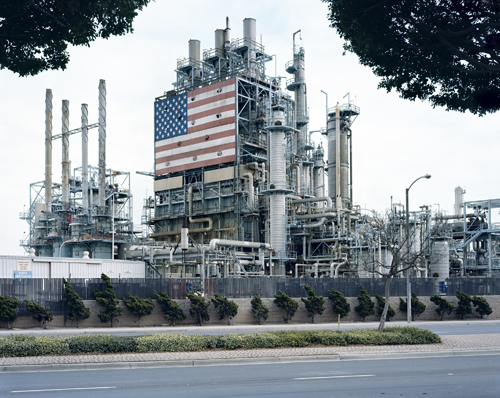
In its summer 2009 issue, Granta features a selection of 15 large-format, color images from the collection. (Only the cover is available online; more images are available on Epstein’s site). The subject has been explored before in aerial photographs by Alex MacLean in Over: The American Landscape at the Tipping Point —straight documentary images that catalog the scale of human excess and consumption—and Emmet Gowin, in Emmet Gowin: Changing the Earth, via artistic black and white abstract impressions of the earth’s surface scarred by energy mining. But Epstein’s photographs, shot from streets and public spaces, taken with his feet rooted on the earth, read more vividly as commentary, a decisive critique of society and its relationship to energy and to the planet, “the human conquest of nature at any cost.”
Traveling across America, Epstein visits the full range of energy production sites, from dirty coal to clean wind, and he captures the interaction between these sites and the communities in which they are entrenched.
The series begins with an oil refinery in California. The imposing structure, with its tangle of industrial pipes that shoot into the air like spires, is a modern day fortress. Photographing from across the street, Epstein locates himself as an outsider, a critic scrutinizing his subject—in this instance, a fortification protected by a moat, a barrier of barbed wire. A synthetic American flag, riddled with holes to protect it from the wind, stretches across the refinery’s façade. Epstein directly makes the association of energy production with American power by foregrounding this diminished icon.
The second image illustrates two stacks from a coal power plant in Georgia spewing smoke into the air. Towers and smoke—a visual pairing imprinted on the American psyche—are recalled, not as an image of a country weakened by attack but by a self-inflicted wound.
The third image—which adorns the journal’s cover—juxtaposes the all-American high school football team, an idyll of youth in their patriotic red jerseys, with a pollution-billowing coal power plant hovering over the field. The toxic air they breathe and the poisoned water they drink compromises the health and brawn of these athletes; energy slowly and silently undermines power.
Epstein’s exploration evolves with the continuing association of major symbols of American strength with the sites of energy production and consumption. In California, cattle graze on a brittle, desolate field backgrounded by a hillside wind farm. In West Virginia, a community nestles among the towers of a coal power plant. And in Iowa, a truck stop, boasting images of archetypal Americans in powerful poses on the wall, overflows with the excesses of consumerism.
And in what is perhaps the most curious of the images, golfers tee up on a verdant course set in a desert landscape spotted with wind turbines. In this barren region, water is imported to create an unnatural and impossibly lush field of green, yet at the same time, the wind turbines represent efforts to support sustainable energy. It is a bizarre contradiction, green technology set up against extravagance.
Epstein renders palpable American self-indulgence and immoderation with an image of Las Vegas, where fake pyramids reside alongside tinker-toy towers, pools, palms, and vacationers in decadent repose. And the photographer alludes to extreme weather—a phenomenon heightened by energy exploitation—with images of a battered oil platform off the Alabama coast and the pockmarked surface of the mighty superdome in Louisiana. Hurricane Katrina ravaged both.
Human figures populate his landscapes only sparsely. In Pass Christian, Mississippi, a town decimated by Katrina, a man and woman, in an iconic representation of the creation myth, kneel before their depleted harvest in a grim garden setting, as if being punished for some original sin. And in Midland, Texas, two motorcyclists appear in full latex coverings. Like futuristic warriors, they are armored and wear helmets designed to filter the contaminated air. Thor, the Viking god celebrated for his enormous strength, is brandished across their chests.
Using the 8x10-inch format, Epstein allows the minute details from within the setting to emerge while exposing the broad scope of the expansive landscape. The viewer oscillates between the interior and exterior spaces, ascribing emotions and identifying with characters from within while simultaneously reading the larger terrain with critical perspective.
Each photograph tells a story, and together the photographs convey the complete narrative. Without making environmental prescriptions or political recommendations, Epstein exposes different facets of the same challenge. The evidence mounts, revealing a complex problem that stretches from coast to coast. Together the images represent a clear visualization of a country that fights against its own self-interest.
The collection of images, with its breadth of hypocrisies and tangle of contradictions, poses a question: “How can a society that functions in this way be sustained?” When asked why he made this work, Epstein simply replied, “I have a daughter.”
Reflecting Epstein’s main motivation, the narrative concludes on a cautionary note with a hint of hope. In the final photograph, an image of the Hoover Dam, the hydroelectric triumph of the 1930s, a glimmer of sunlight shines on the horizon, while the “bathtub ring” on the basin surface below signals the retreating waterline of Lake Mead. The image realizes Epstein’s intentions, to expose “the beauty and terror of early twenty-first-century America as it clings to past comforts and gropes for a more sensible future.”
------------------
Stephanie Mitchell is a professional photographer whose work has appeared in The New York Times, The Boston Globe, Boston Herald, The Irish Times, Der Spiegel, and TIME magazine.
 Mitch Epstein’s "American Power" depicts the landscape as political narrative. The American photographer, who has chronicled cultural complexities in India and Vietnam, now homes his camera in on dissonances within his own culture. The subject of "American Power" is energy in America—its production, consumption, and unintended consequences. And embedded in the terrain of the images is a critique of American power in the other sense of the word—its destructiveness and contradictions. Like an unflattering mirror, Epstein’s pictures reflect back the troublesome realities that the exercise of American power can create.
Read the
Mitch Epstein’s "American Power" depicts the landscape as political narrative. The American photographer, who has chronicled cultural complexities in India and Vietnam, now homes his camera in on dissonances within his own culture. The subject of "American Power" is energy in America—its production, consumption, and unintended consequences. And embedded in the terrain of the images is a critique of American power in the other sense of the word—its destructiveness and contradictions. Like an unflattering mirror, Epstein’s pictures reflect back the troublesome realities that the exercise of American power can create.
Read the 

